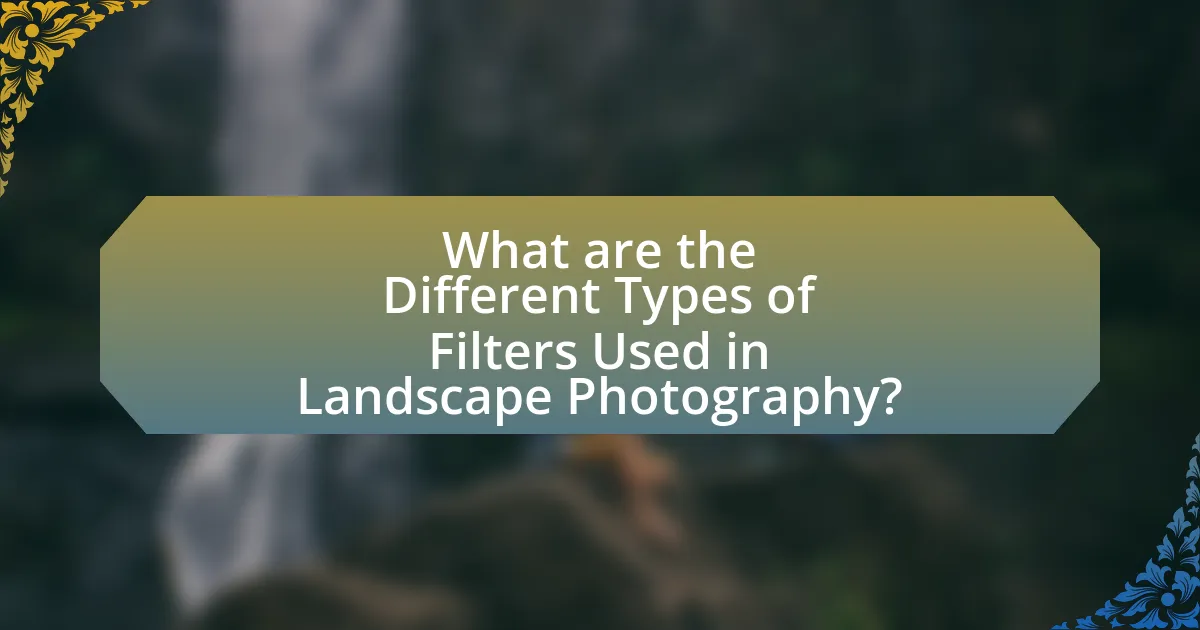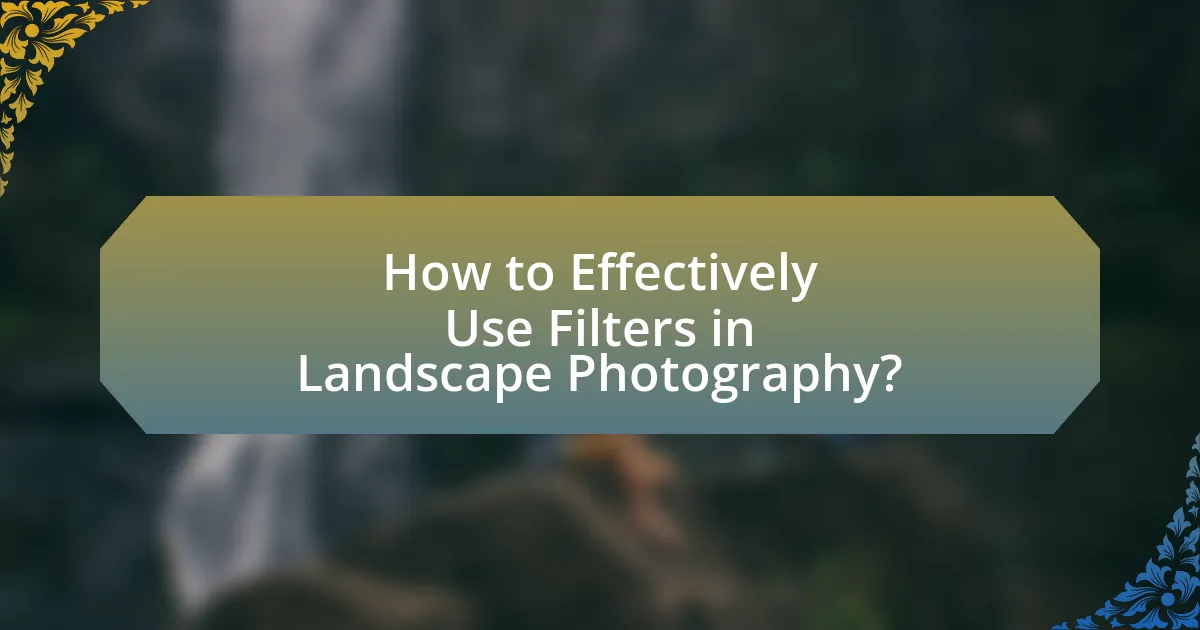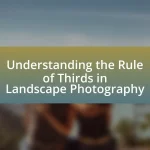The article focuses on the use of filters in landscape photography, detailing their role as optical devices that modify light entering the camera. It explains various types of filters, including polarizing, neutral density, and graduated neutral density filters, and their specific functions in enhancing image quality by controlling exposure and color balance. The article also addresses the importance of filters for achieving artistic effects, the challenges faced without them, and best practices for their effective use in the field. Additionally, it provides practical tips for beginners on selecting and maintaining filters to optimize their landscape photography.

What are Filters in Landscape Photography?
Filters in landscape photography are optical devices placed in front of the camera lens to modify the light entering the camera. They serve various purposes, such as enhancing colors, reducing glare, and controlling exposure. For instance, polarizing filters can reduce reflections from water surfaces and increase color saturation, while neutral density filters allow for longer exposure times without overexposing the image. The effectiveness of filters is supported by their widespread use among professional photographers, who rely on them to achieve specific artistic effects and improve image quality.
How do filters enhance the quality of landscape photographs?
Filters enhance the quality of landscape photographs by controlling light and color, resulting in more vivid and balanced images. For instance, polarizing filters reduce glare from reflective surfaces like water and wet foliage, enhancing color saturation and contrast. Neutral density filters allow for longer exposure times, enabling photographers to capture motion in elements like water and clouds, which adds a dynamic quality to the image. Additionally, graduated neutral density filters help balance exposure between bright skies and darker landscapes, preventing overexposure in highlights while maintaining detail in shadows. These techniques collectively contribute to a more visually appealing and professionally polished photograph.
What types of filters are commonly used in landscape photography?
Commonly used filters in landscape photography include polarizing filters, neutral density filters, and graduated neutral density filters. Polarizing filters reduce reflections and enhance color saturation, making skies bluer and foliage greener. Neutral density filters allow for longer exposure times without overexposing the image, which is particularly useful for capturing motion in water or clouds. Graduated neutral density filters balance exposure between the bright sky and darker land, preventing loss of detail in highlights. These filters are essential tools for landscape photographers aiming to achieve optimal image quality and visual impact.
How do different filters affect exposure and color balance?
Different filters significantly influence exposure and color balance in photography. Neutral density filters reduce the amount of light entering the lens, allowing for longer exposure times without overexposing the image, which is particularly useful in bright conditions. Polarizing filters enhance color saturation and contrast by reducing reflections and glare, resulting in deeper blues in the sky and more vibrant greens in foliage. Additionally, color filters can alter the color balance by emphasizing or diminishing specific wavelengths of light, such as warming tones with a yellow or orange filter. These effects are well-documented; for instance, a study by the American Society of Photographers highlights how polarizing filters can increase color saturation by up to 30%, demonstrating their impact on both exposure and color fidelity.
Why are filters important for landscape photographers?
Filters are important for landscape photographers because they enhance image quality and control light conditions. Specifically, polarizing filters reduce glare and reflections from water and foliage, allowing for richer colors and improved contrast. Neutral density filters enable longer exposures in bright conditions, facilitating effects like smooth water surfaces or motion blur in clouds. Additionally, graduated neutral density filters help balance exposure between the sky and land, preventing overexposure in bright areas. These tools are essential for achieving the desired artistic vision and technical precision in landscape photography.
What challenges do landscape photographers face without filters?
Landscape photographers face significant challenges without filters, primarily in managing exposure and achieving desired image quality. Without filters, photographers struggle with overexposed highlights in bright conditions, as filters like neutral density (ND) help to reduce light entering the lens, allowing for longer exposures and better control over depth of field. Additionally, the absence of polarizing filters can lead to less saturated colors and unwanted reflections, particularly in water and foliage, which diminishes the overall impact of the landscape. Research indicates that using filters can enhance dynamic range and color accuracy, making them essential tools for capturing the full essence of a scene.
How can filters help in achieving specific artistic effects?
Filters can help achieve specific artistic effects by altering light and color in landscape photography. For instance, polarizing filters reduce glare and enhance color saturation, making skies appear bluer and foliage more vibrant. Neutral density filters allow for longer exposure times, enabling effects like smooth water surfaces or blurred motion in clouds, which adds a dynamic quality to the image. Additionally, graduated neutral density filters balance exposure between bright skies and darker landscapes, creating a more harmonious composition. These techniques are widely recognized in photography, as evidenced by the consistent use of filters in professional landscape photography to enhance visual storytelling and artistic expression.

What are the Different Types of Filters Used in Landscape Photography?
The different types of filters used in landscape photography include polarizing filters, neutral density filters, graduated neutral density filters, and UV filters. Polarizing filters reduce reflections and enhance color saturation, making skies bluer and foliage greener. Neutral density filters limit the amount of light entering the lens, allowing for longer exposure times, which is useful for capturing motion in water or clouds. Graduated neutral density filters balance exposure between the bright sky and darker land, preventing overexposure in high-contrast scenes. UV filters protect the lens from dust and scratches while having minimal impact on image quality. Each filter serves a specific purpose that enhances the overall quality of landscape photographs.
What is a polarizing filter and how does it work?
A polarizing filter is an optical filter that reduces reflections and enhances color saturation in photography. It works by allowing light waves of a specific polarization to pass through while blocking others, effectively minimizing glare from surfaces like water and glass. This selective filtering occurs because the filter is made of a special polarizing material that can be rotated to adjust the angle of polarization, enabling photographers to control the amount of reflected light entering the camera. The result is clearer images with improved contrast and vibrant colors, particularly in landscape photography where the sky and foliage can be significantly enhanced.
What effects does a polarizing filter have on landscapes?
A polarizing filter enhances landscapes by reducing reflections and increasing color saturation. This filter minimizes glare from surfaces like water and wet foliage, allowing for clearer images. Additionally, it enhances the contrast between the sky and clouds, making blue skies appear deeper and clouds more defined. Studies show that using a polarizing filter can increase color saturation by up to 50%, significantly improving the visual impact of landscape photographs.
When should a polarizing filter be used in landscape photography?
A polarizing filter should be used in landscape photography when the photographer aims to reduce reflections and enhance color saturation. This filter is particularly effective when photographing scenes with water, foliage, or skies, as it can eliminate glare from surfaces and deepen the blue of the sky. Studies show that using a polarizing filter can increase contrast and vibrancy in images, making landscapes appear more dynamic and visually appealing.
What is a neutral density (ND) filter and its purpose?
A neutral density (ND) filter is a photographic filter that reduces the intensity of light entering the camera lens without affecting the color of the scene. The primary purpose of an ND filter is to allow for longer exposure times or wider apertures in bright lighting conditions, enabling photographers to achieve effects such as motion blur in water or clouds, and to control depth of field. ND filters are measured in stops, with common values including 3-stop, 6-stop, and 10-stop filters, which correspond to the amount of light they block. This capability is particularly beneficial in landscape photography, where managing light exposure is crucial for capturing the desired aesthetic.
How does an ND filter affect exposure times in landscape photography?
An ND (Neutral Density) filter reduces the amount of light entering the camera lens, which directly increases exposure times in landscape photography. By allowing photographers to use longer shutter speeds, ND filters enable creative effects such as smooth water surfaces or motion blur in clouds, which would not be possible with standard exposure settings. For example, a 6-stop ND filter can increase exposure time from 1/60 second to 1 second, allowing for significant creative control over the final image. This capability is essential for capturing dynamic landscapes under bright conditions, where longer exposures can enhance the visual impact of the photograph.
What are the different strengths of ND filters available?
Neutral Density (ND) filters are available in various strengths, typically categorized by their optical density or the amount of light they block. Common strengths include ND2, ND4, ND8, ND16, ND32, and ND64, which correspond to a light reduction of 1 stop, 2 stops, 3 stops, 4 stops, 5 stops, and 6 stops, respectively. Each strength allows photographers to control exposure and achieve desired effects, such as motion blur in water or clouds, while maintaining image quality. The effectiveness of these filters is widely recognized in landscape photography, where managing light is crucial for capturing dynamic scenes.
What is a graduated ND filter and when should it be used?
A graduated ND (Neutral Density) filter is a photographic filter that reduces the intensity of light entering the camera, with a gradient that transitions from dark to clear. This filter is primarily used in landscape photography to balance exposure between the bright sky and darker foreground, preventing overexposure in the sky while maintaining detail in the land. Photographers should use a graduated ND filter when capturing scenes with a significant difference in brightness, such as sunsets or sunrises, where the horizon line divides the bright sky from the darker landscape.
How does a graduated ND filter help balance exposure in landscapes?
A graduated ND filter helps balance exposure in landscapes by reducing the light intensity in the brighter areas of a scene, such as the sky, while allowing more light to pass through the darker areas, like the foreground. This selective light reduction prevents overexposure in the highlights and underexposure in the shadows, resulting in a more evenly exposed image. For example, when photographing a sunset, a graduated ND filter can darken the sky without affecting the brightness of the land below, thus maintaining detail in both areas. This technique is widely used in landscape photography to achieve a balanced exposure that captures the full dynamic range of a scene.
What are the best practices for using graduated ND filters?
The best practices for using graduated ND filters include proper positioning, selecting the right density, and ensuring accurate exposure. Position the filter so that the transition line aligns with the horizon or the area of interest in the scene, which helps to balance the exposure between the sky and the foreground. Choose a density that effectively reduces the brightness of the sky without overly darkening the foreground; common densities range from 0.3 to 0.9, corresponding to 1 to 3 stops of light reduction. Additionally, use a tripod to maintain stability and avoid camera shake during long exposures, ensuring that the filter does not introduce unwanted blurriness. These practices enhance the overall image quality by achieving a well-balanced exposure across the landscape.

How to Effectively Use Filters in Landscape Photography?
To effectively use filters in landscape photography, photographers should select the appropriate type of filter based on the desired effect, such as polarizing filters to reduce glare and enhance colors, or neutral density filters to control exposure in bright conditions. Polarizing filters can increase contrast in the sky and saturate colors, particularly in landscapes with water or foliage, while neutral density filters allow for longer exposure times, enabling the capture of motion in elements like water or clouds. Research indicates that using these filters can significantly improve image quality by managing light and enhancing visual elements, as demonstrated in studies on photographic techniques and their impact on image aesthetics.
What are the best techniques for using filters in the field?
The best techniques for using filters in the field include understanding the types of filters available, such as polarizing filters, neutral density filters, and graduated neutral density filters, and applying them effectively to enhance landscape photography. For instance, polarizing filters reduce glare and enhance color saturation, particularly in skies and foliage, while neutral density filters allow for longer exposure times, enabling smooth water effects or motion blur in clouds. Graduated neutral density filters help balance exposure between bright skies and darker landscapes, preventing overexposure in highlights. These techniques are validated by the fact that professional photographers often rely on filters to achieve specific visual effects, as evidenced by their frequent use in award-winning landscape photography.
How can you determine the right filter for a specific scene?
To determine the right filter for a specific scene, assess the lighting conditions and desired effects. For example, a polarizing filter reduces glare and enhances colors in bright sunlight, making it ideal for capturing vibrant landscapes. Conversely, a neutral density filter allows for longer exposure times in bright conditions, enabling effects like smooth water surfaces. Understanding the scene’s characteristics, such as the presence of reflections or the need for motion blur, guides the selection of the appropriate filter.
What tips can improve the effectiveness of filters in landscape shots?
To improve the effectiveness of filters in landscape shots, photographers should consider using polarizing filters to reduce glare and enhance colors, particularly in skies and foliage. Polarizing filters can increase contrast and saturation, making the landscape appear more vibrant. Additionally, using neutral density (ND) filters allows for longer exposure times, which can create smooth water effects and capture motion in clouds, enhancing the overall composition. It is also beneficial to ensure that filters are clean and free of scratches, as any imperfections can degrade image quality. Lastly, experimenting with different filter strengths and combinations can yield unique results tailored to specific lighting conditions and desired effects.
What common mistakes should be avoided when using filters?
Common mistakes to avoid when using filters include selecting the wrong type of filter for the desired effect, which can lead to suboptimal image quality. For instance, using a polarizing filter in low light can result in underexposed images. Additionally, neglecting to check for vignetting, especially with wide-angle lenses, can cause unwanted dark corners in photographs. Another mistake is failing to clean filters properly, which can introduce unwanted artifacts or reduce clarity. Lastly, overusing filters can lead to unnatural images, as excessive filtering may distort colors and details.
How can improper filter use affect image quality?
Improper filter use can significantly degrade image quality by introducing unwanted artifacts, color casts, and reduced sharpness. For instance, using a polarizing filter incorrectly can lead to uneven color saturation and darkened skies, which detracts from the natural appearance of the landscape. Additionally, stacking multiple filters can cause vignetting and loss of detail in the corners of the image, as evidenced by studies showing that excessive filtration can reduce overall image clarity by up to 30%. Therefore, understanding the correct application of filters is crucial for maintaining high image quality in landscape photography.
What are the signs of over-filtering in landscape photography?
The signs of over-filtering in landscape photography include unnatural color saturation, loss of detail in highlights and shadows, and an overall flat appearance in images. Unnatural color saturation occurs when filters, particularly polarizers or ND filters, are applied excessively, resulting in colors that appear unrealistic. Loss of detail in highlights and shadows happens when filters are used to darken skies or enhance contrast, leading to clipped highlights or blocked shadows. An overall flat appearance indicates that the image lacks depth and dimension, often due to overuse of filters that suppress natural gradients and textures. These signs collectively indicate that the filtering process has been taken too far, compromising the quality of the photograph.
What are some practical tips for beginners using filters?
Beginners using filters should start with a polarizing filter to reduce glare and enhance colors in landscape photography. This type of filter can make skies appear bluer and foliage more vibrant, improving overall image quality. Additionally, beginners should experiment with neutral density (ND) filters to control exposure and achieve longer shutter speeds, which can create smooth water effects or motion blur in clouds. It is also important for beginners to understand the correct filter size for their lens to avoid vignetting. Lastly, practicing proper filter maintenance, such as cleaning and storing filters correctly, will ensure optimal performance and longevity.
How can beginners choose their first set of filters?
Beginners can choose their first set of filters by selecting essential types that enhance landscape photography, such as polarizing filters and neutral density filters. Polarizing filters reduce glare and enhance colors, making skies bluer and foliage greener, which is crucial for landscape shots. Neutral density filters allow for longer exposure times without overexposing images, enabling effects like smooth water surfaces or blurred clouds. Research indicates that using these filters can significantly improve image quality and creative possibilities in landscape photography.
What are the essential maintenance tips for filters?
Essential maintenance tips for filters include regular cleaning, proper storage, and timely replacement. Cleaning filters with a microfiber cloth and lens cleaning solution prevents dust and smudges from affecting image quality. Proper storage in a protective case or pouch avoids scratches and damage when not in use. Additionally, filters should be replaced if they show signs of wear, such as scratches or discoloration, to ensure optimal performance. Regular maintenance extends the lifespan of filters and maintains the quality of landscape photography.















